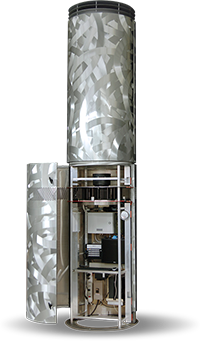ASAP V Operational Details
Overview

architectural column
Each ASAP V node consists of a central instrument box that houses communication electronics and those sensor modules that need to be centrally located, such as the aerosol biohazard module. Others such as video and sound modules may be mounted externally and can be supplied in a cabled format. CBRN International will provide a customized solution that best meets each customer's requirements.
Windows-based software allows easy integration of the diverse modules. They may be operated stand-alone or in conjunction with other modules in a master/slave mode. A wide range of master/slave connection options and programmed sampling and analysis protocols are provided.
For example, a bio-aerosol detector may be used to detect any unusual increase in the bio-aerosol background. The system can be programmed to provide a visual and/or sound alarm on a monitoring PC, as well as turn on an aerosol sampler that collects particulates into a small volume of water.
When a specified collection time has elapsed, the collected sample will be transferred to a wet bioassay module that determines if suspect biological threat agents are present. Results are then relayed to the local or remote monitoring PC. This collection and identification protocol takes about 20 minutes.

dry air sampler
As a second example, a radiation detection module may sense an abnormally high radiation background. The system can be programmed to signal this event to the monitoring PC, and to run a programmed collection protocol using a high-efficiency dry filter system. CBRN International can provide this functionality based either on the SASS® 3100 or SASS® 4100 dry filter aerosol particle collectors.
The Windows-style user interface also provides operators with immediate visual feedback regarding the status of the individual sensors. By a button click, the user can examine each detector’s output over the past 24 hours. Through pull-down windows, each detector’s performance can be examined or adjusted as appropriate for immediate conditions. A permanent record of each module’s data is stored for archival study.
BIOLOGICAL AGENTS

bioassay
Air sampling for bio-aerosols may be implemented using CBRN International’s SASS® 2300 multiple-effect wet air sampler, or for higher sensitivity, the SASS® 4000 aerosol concentrator may be used to produce an aerosol concentrate. Wet antibody-based bioassays may be performed on-site using bioassay modules based on either CBRN International’s RAPTOR™ four-channel bioassay system, or its eight-channel BioHawk® bioassay system.
The RAPTOR and BioHawk systems use patented multiple-use assay coupons that provide up to 30 assays before the coupon must be replaced. This greatly minimizes per-measurement and life cycle assay costs for the ASAP V/CIP as compared to other wet bioassay strategies.
CHEMICAL AGENTS
Airborne chemical agents are detected using an ion mobility spectrometer produced by a major world manufacturer. The module offers fast and reliable detection of a wide range of airborne toxic industrial chemicals and chemical warfare agents. The unit provides continuous real time operation with a response time of only a few seconds.
NUCLEAR MATERIALS

gamma neutron detector
Two modules are available based on Russian gamma ray scintillator products. One module is amenable to portal monitoring situations where the presence of radio-isotopes and special nuclear materials are of concern at an entry point to a controlled area. The second module is more suited for area monitoring gamma ray background levels.
METEOROLOGICAL
This module is based on meterological systems provided by Coastal Environmental Systems of Seattle, WA. Sensors can be provided for wind speed and direction, relative humidity, temperature, pressure, visibility, and precipitation. Optionally the system can monitor the area with video.
EXPLOSIVES
The presence of unusual levels of explosive vapors and particulates is determined using a module based on Morpho System’s MobileTrace ITMS technology. Analysis and reporting times are under 10 seconds.
INTRUSION DETECTION
Several intrusion detection technologies are available, based on detection methods ranging from microwave to acoustic. Please let us know what the approximate dimensions (height x width x depth) of your monitored surveillance area are, and the normal operating temperature range, and we will provide one or more recommended solutions.
THERMAL IMAGING
Body temperature imaging (8 to 14 microns, typ.) is an excellent method for performing covert surveillance or fire detection, among other functions. Microbolometer technologies have now made this a cost-effective technology to incorporate into the ASAP II/CIA. Thermal imagers can be installed with arrays ranging up to 96 x 96 in size.


